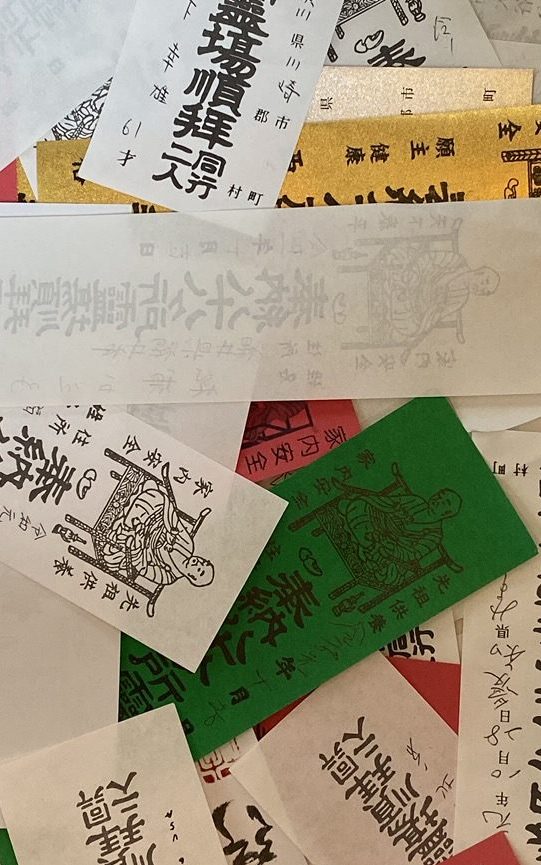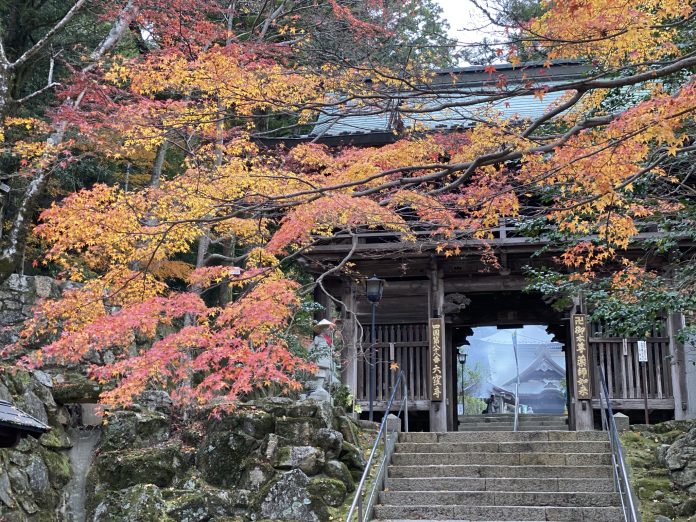The shikoku pilgrimage is now the most famous Japanese pilgrimage inside and outside of Japan. What used to be mainly Buddhist Japanese locals is now full of foreign adventure seeking tourists as well. Over 180,000 domestic and foreign pilgrims visit the area each year. Wrapping its self around the outer edges of the island of Shikoku just south of Osaka the pilgrimage covers 88 separate Buddhist temples that form a ring around the island. It is one of the very few circular pilgrimages in the world where you start and end at the same place. The trip will begin and end at Temple 1 located in Tokushima. Because of the cyclical nature of the pilgrimage it is said that once the pilgrimage is started it said to never end. It is not uncommon for pilgrims to complete the pilgrimage many times throughout their life. Some domestic pilgrims have even completed the pilgrimage more than 100 times.
The route follows the path of Kobo Daishi, Japan’s most famous monk who studied Buddhism in China and brought Buddhist teachings to Japan. Upon his return he founded Shingon Buddhism and made the top of Mt Koya in Wakayama its home. He is also credited as the creator of the Hiragana writing system used in Japan which simplified their writing system. Shikoku is both where Kobo Daishi was born but also where he is said to have reached enlightenment. Kobo would travel the island teaching at the temples and helping the community.

It wasn’t until the 16th century that a guide book was published in Japan for pilgrim tourists that the official route of the 88 temples took shape. While Kobo traveled between the temples, we don’t have any records of the exact route that he took. The published work made use of well-worn paths already made though areas by the locals so we can only assume Kobo would have used these same routes in his travels. The original pilgrimage dates back for more than 1000 years, but its popularity only grew after the guide was published.
The pilgrimage starts in the north east of the island of shikoku and follows a clockwise route around the island. It mostly sicks to the edges of the island and will travel though the 4 major prefectures that make up the island. Tokushima to the east, Kochi in the south, Ehime in the north west, and Kagawa in the north east. Each prefecture has its own unique culture, food, and traditions. Beyond the pilgrimage all of them are worth visiting on their own. Around the island are also countless tourist attractions and activates. Shikoku is famous even without the pilgrimage for domestic vacations in Japan for its diverse landscapes and activities. It’s highly recommended that foreign pilgrims allow for extra time to enjoy all that the island has to offer which also helps support the local community.
The entire shikoku pilgrimage if you were to walk the official route is 1,200km (124 Miles) and will take a person 40-50 days of traveling. The most hardcore pilgrims will make sure to cover 30km per day (18.6 Miles) to keep pace. But the most common way by far is to do the pilgrimage by bus or car. The vast majority of pilgrims on the route are domestic travelers in Japan and one of the most popular ways is on organized bus trips. These bus trips take about 8 days and all food and accommodation are covered. Most foreigners are doing the pilgrimage for the challenge and adventure so they are most commonly walking, cycling, or doing a mix mode of transportation. For example, if you were on a bicycle the route would take around 17 days of riding, half the time it takes to walk. By car most people will complete the pilgrimage in about a week.

At each temple the pilgrim is supposed to do several things. First, is to visit the main hall of the temple dedicated to Buddha and make an offering, light incense, place a name slip, and pray. Offerings are cash in the form of coins that you toss into the offering box in front of the temple. This is usually one or two 100yen coins which is roughly $1 USD per coin. Incense should be exactly 3 sticks that are lit and placed together. Optionally one can also light a single candle at each hall. Next, they head over to the Daishi Hall dedicated to Kobo Daishi which is usually smaller than the main hall. Here they repeat the same steps as the first hall. After this is done, they then visit the temples Nokyo office and have their Nokyocho book stamped and signed by the temple staff. This signature and stamp also cost’s 300yen so each temple will cost a pilgrim roughly $4-7 USD which really adds up across the 88 temples.
One of the main goals of the pilgrimage is to fully fill out the Nokyocho. The Nokyocho is a book that is used to collect stamps and signatures from each temple visited. Each temple has a unique dated stamp and calligraphy signature which is hand written by a monk at each temple. Nokyocho’s come in all shapes and sizes, many are sold specifically for this pilgrimage and will have a specific page for each temple often with art and history about that temple on the opposite page. Once completed the Nokyocho serves as a talisman of karma. Many Japanese pilgrims are buried with their Nokyocho hoping that it will help aid them in the afterlife. Because of this you may find pilgrims getting an extra book stamped which to bring home to an older loved one. It is common for pilgrims to complete the pilgrimage many times and they will continue to use the same book their whole life.
The name slip that we mentioned above is also a large part of the pilgrimage. Known as Osamefuda a name slip is a small rectangular piece of paper that pilgrims will write their name, age, address, and small notes on. These are placed in boxes next to each prayer hall and will later be burned by temple staff as part of ceremony. These slips are not just offered at temples but also traded between pilgrims like business cards and they are given to locals who provide a gift or help to the pilgrim on their journey. Across the route there are small businesses that may have part of their wall plastered with name slips from pilgrims over the years. These name slips also have a tier system to them based on the number of times the pilgrim has completed the entire 88 temple journey. 1-4 is plain white, 5-7 is green, 8-24 is red, 25-49 is silver, 50-99 is gold, and 100+ is a special brocade fabric slip called Nishiki.

Pilgrims traditionally wore white while on the pilgrimage because it was quite dangerous and many would die on the route. White is the color of funeral dress in Japan so by wearing white it meant that a pilgrim was ready for death if discovered on the trail. The modern pilgrimage is incredibly safe but pilgrims still are expected to wear white as tradition and some say it also now symbolizes purity in the pilgrim. The white top that pilgrims wear is called a Hauki and is usually long sleeve. There is a sleeveless version as well called a Hakui sode nashi which just translates to sleeveless. Written on the backs of these Hauki is often the phrase Namu Daishi Henjō Kongō which translates roughly as Homage to the Savior Daishi, the Illuminating and Imperishable One. The long sleeve Hauki is often heavy fabric and not very breathable so if you are planning to hike or walk much of route in warmer weather it is highly recommend finding the sleeveless one.
Pilgrims will also commonly carry two other items that will mark them as pilgrims. The second item is a bamboo woven conical hat called a Sugegasa. Traditionally this hat was to protect the pilgrim from the sun and rain but the modern versions are not constructed as well. While it will still keep the sun off your head, they are no longer waterproof and now come with plastic rain covers. Written on the hat is a poem and in the front is the kanji character for Kobo Daishi which represents the front of the hat. The second item is a walking staff with a small bell attached to it called Kongotsue. All pilgrims are expected to have this walking stick even when traveling by bus because the staff is supposed to represent Kobo Daishi himself. Because of this you pilgrims are expected to treat their staff with respect. Staffs should only be placed in the staff holders at temples and there is a tradition where you clean the bottom of your staff with water before entering your lodging for the night. This can be seen as cleaning the feet of Kobo Daishi out of respect. Many staffs will also have a phrase written on them that roughly translates to “we two walk together”. The bell on the staff is supposed to keep the pilgrim in the moment as they walk and to help maintain mindfulness along the journey. If walking the staff will be invaluable on assisting you up the hills and though the mountains of shikoku. You will certainly feel the helping hand of Kobo Daishi as you hike the route.
Other items that pilgrims will can have are a narrow scarf called a Wagesa and a holding bag called a Fudabasami. The wagesa is a layman’s version of the stole worn by Buddhist priests and by wearing it you are stating that you are on a Buddhist journey. You will most commonly see the older Japanese pilgrims wearing these but not many foreigners. The Fudabasami is a white bag that the pilgrim carries to hold items on their journey, namely the Nokyocho the book that all pilgrims carry to collect temple signatures in. These bags will often have a large pocket for the book and then smaller pockets for incense, name slips, candles, and a lighter. Both of these items are optional and there is not a religious reason to use the Fudabasami to hold the Nokyocho.

This pilgrimage is an absolutely amazing journey that will take you from beaches, to bamboo forests, to endless rice fields, and to the highest forested mountain peaks that Shikoku has to offer. Along the way you will encounter the friendly locals who have spent their life helping and directing pilgrims on their journey. Many of whom will offer pilgrims small gifts called Osetai. Since each pilgrim is supposed to represent Kobo Daishi himself any offerings made are also made to Kobo Daishi himself. While the idea of a 40-50 day trip is daunting to most, there is also no official time line pilgrims need to follow and no temple order is required. Many pilgrims will do smaller sections as parts of personal vacations. So long as all 88 temples are visited it doesn’t matter how long the journey took or what order the temples were visited which makes it a very appealing pilgrimage for those without time to complete the whole thing in one visit.



